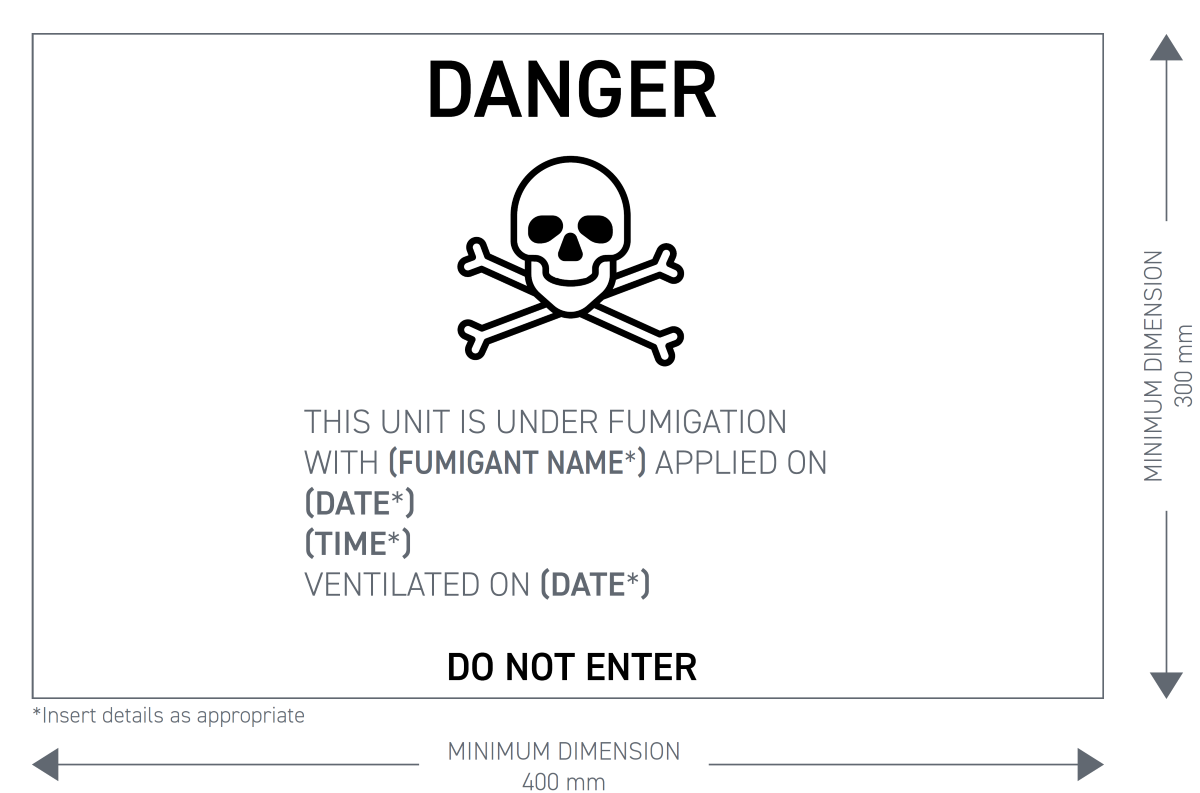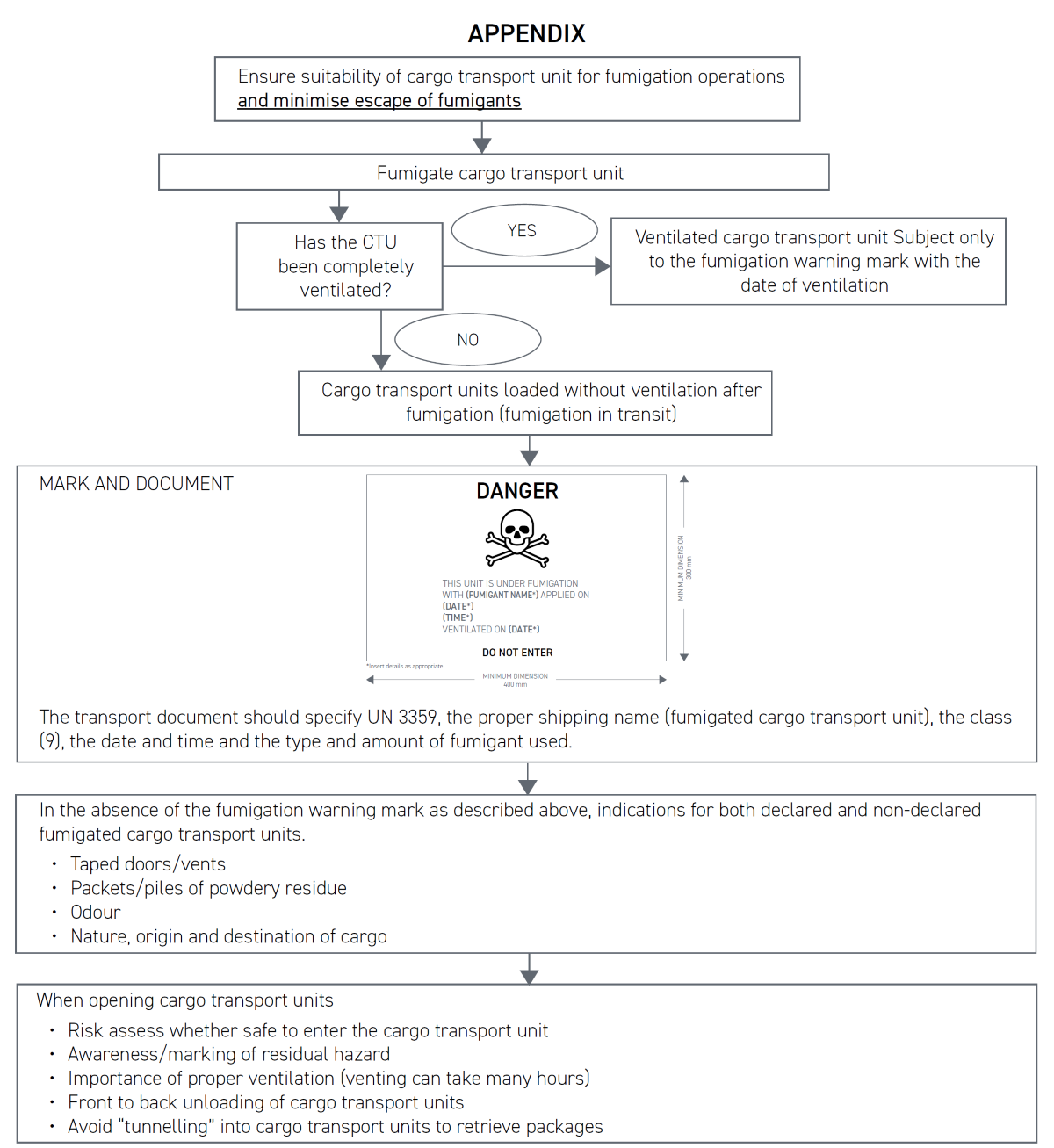CARGO FUMIGATION IN CONTAINERS
Published: 5 June 2024
The surge in popularity of container shipping stems from its convenience and fast turnaround time. This transportation method utilises standardised cargo transport units (CTUs) to facilitate seamless handling, transportation, and storage of cargo without direct handling, particularly regarding dangerous goods or fumigated cargoes.
A fumigated CTU is a closed CTU, such as a multimodal freight container, carrying goods or materials that have been fumigated within the unit. The fumigant gases used in this process are either poisonous or asphyxiant, typically released from solid or liquid preparations distributed within the unit¹.
Transporting such units poses potential risks to the ship’s crew, requiring the implementation of rigorous safety measures to safeguard the well-being of on board personnel. Therefore, the containers used in this process must close in a manner that minimises gas loss², ensures proper sealing and effectively contains fumigant gases within the containers during the voyage.
The Club previously published an insight into fumigation, and this article will further highlight the risks and raise awareness of the necessary safety precautions for transporting fumigated containerised cargoes.
FUMIGATION FOR CONTAINERISED CARGOES
The containerised cargoes that are mot likely to undergo fumigation include foodstuffs, grain, leather goods, handicrafts, textiles, time or crane furniture, luxury vehicles and cargo in timber cases or on timber pallets.
Operators introduce fumigant gases into these containers during transit or before stuffing empty containers to prevent pest-related deterioration of the goods.
Unlike bulk carriers, cargoes loaded in fumigated containers present a different set of problems to the crew. While these commonly used fumigants resemble those utilised on bulk carriers, such as phosphine, methyl bromide, or formaldehyde, nobody can practically and visually monitor the hazards during the voyage with sealed containers.
Containers transported under fumigation containing no other Dangerous Goods (DG) should be carried in accordance with the IMDG Code under “UN 3359 – Fumigated Cargo Transport Unit, Class 9”, and provided with a proper shipping name. If any fumigant gas has been used as part of the packing process, then a fumigation warning mark (figure 1), should be displayed as per IMDG Code3 and Code of Practice for Packing of Cargo Transport Units (CTU Code)⁴.

Note that Class 9 placards should not be affixed to a fumigated container unless class 9 goods are carried inside the container.
If the containers have not been ventilated before loading, they should be properly sealed and marked with date and time of fumigation, and the type of fumigant used. Shippers should provide the master with a dangerous goods transport document, including Safety Data Sheets (SDS) with guidance on the Emergency Schedule (EmS) and a Medical First Aid Guide (MFAG).
If the containers have been completely ventilated before loading, the date of ventilation should be added to the fumigation warning mark(s). In such circumstances, the transport documents described above are not required.
When the fumigated container has been both completely ventilated and unloaded, then the fumigation warning mark(s) should be removed.
The flowchart in the appendix of the International Maritime Organization (IMO) Revised Recommendation On The Safe Use Of Pesticides In Ships Applicable To The Fumigation Of Cargo Transport Units⁵ provides a good summary of the above requirements.

PRIOR TO LOADING
The shipper or exporter must accurately declare the fumigated containers and obtain permissions from local authorities to load them onto the ship.
Carriers typically depend on accurate declarations to determine the contents of freight containers. Frequently, cargoes are mis-declared or not declared as chemically treated. Carriers should consistently communicate with shippers to enhance cargo traceability and reduce these risks. The packer and fumigator should ensure that the containers transported under in-transit fumigation are fit for purpose. Prior to stuffing, these containers should be cleaned, free of cargo residues, noxious materials, plant products or visible pests. Containers transported under in-transit fumigation should not be allowed on board until sufficient time has passed to allow the fumigant gas to be dispersed throughout the cargo (24 hours is normally considered as adequate). Furthermore, it should be noted that fumigants should not be applied to the cargo contained in the containers once it has been loaded aboard the ship.
Organic chemicals trapped within the goods during the manufacturing process may also release formaldehyde. Toxic gases emanating from substances associated with the cargo’s production process or from the dunnage have, in some cases, reached dangerous levels within the container, beyond the use of fumigants. For instance, shoes may emit high levels of toluene, benzene, and other toxic solvents. Hence, ensuring the containers are structurally sound is crucial to prevent any gas leakages before loading on board.
DURING AND AFTER LOADING
Meanwhile, the master or chief officer should actively acknowledge the fumigated containers and visually confirm that the fumigator has clearly marked the containers with proper warning signs, if necessary.
These signs should state the type of fumigant used and the date of application. For fumigants such as Methyl Bromide, Phosphine and Sulfuryl Fluoride, it may be advisable to place warning signs around the containers to prevent any ship crew from approaching at close distance and being exposed to these poisonous gases.
It is important to note that fumigation does not override the requirement for full compliance with the IMDG Code regarding any dangerous goods carried within the container. Fumigated containers (UN 3359) are classified as stowage category B under the IMDG Code’s DG List column (16a) and stowage is therefore permitted either on or under deck. However, it’s preferable to stow fumigated in-transit (non-ventilated) containers on deck to prevent any escaping fumigant from creating a lethal atmosphere within an enclosed space. These containers should remain intact and should be clear of living quarters. If fumigated containers are stowed under deck, then cargo spaces should be equipped with mechanical ventilation to prevent any fumigation gas from building above the threshold limit value set out by the competent authorities or stated in the SDS⁶.
The master and crew should always double-check the location of the loaded fumigated containers to confirm they are loaded according to the stowage plan and meet the requirements to be clear from the living quarters. Additionally, it’s advisable to position these containers away from ventilator intakes and refrigerated containers to the extent practical. This minimises the risk of drawing poisonous gas leaked from the fumigated containers and reduces interaction with them during the ship crew’s daily routine checks of the refrigerated containers.
The dynamic sea conditions, including rolling and pitching, could shift the cargoes within the containers and compromise the container’s integrity, leading to potential gas leaks. The ship should be provided with suitable gas detection equipment⁷ on board and ship’s crew provided with adequate personal protective equipment (PPE) including respiratory protective equipment, gloves, goggles or protective suits as part of the precautions on board.
Furthermore, the crew should be aware of the safety protocols when handling these fumigated containers and the master should ensure crew are trained to respond in emergencies involving
fumigated containers. It is also recommended for the crew to conduct a risk assessment, taking into account the fumigants present and the duration of exposure.
For containers subject to fumigation in-transit (not ventilated prior to loading), the master should obtain and comply with any reporting requirements for the port of destination and any ports of call enroute. This typically involves providing 24 hours’ notice along with details of the fumigant used, date of fumigation and location of fumigated units.
The transportation of fumigated containers presents inherent risks, often exacerbated by inadequate information, improper labelling, container integrity issues, and substandard handling practices. To mitigate these risks, adherence to regulations, rigorous safety protocols, and effective communication between all parties involved are paramount. Through comprehensive education, equipment, and strict adherence to safety standards, the industry can ensure the safe and efficient transportation of fumigated containers, safeguarding both the cargoes and the individuals responsible for its transportation.
For further information regarding the risks associated with fumigation the Club has issued an insight Fumigation – An Overview For the Maritime Sector.
For further information, please do not hesitate to email lossprevention@tindallriley.com.
BIBLIOGRAPHY
1 International Maritime Dangerous Goods (IMDG) Code, volume 2, Chapter 3.2: Dangerous Goods list
2 MSC.1/Circ.1361/Rev.1 : Revised Recommendations on the Safe Use of Pesticides in Ships Applicable to the Fumigation of Cargo Transport Units, 2022
3 International Maritime Dangerous Goods (IMDG) Code, volume 1, Chapter 5.5: Special Provisions
4 MSC.1/Circ.1497 : IMO/ILO/UNECE Code of Practice for Packing of Cargo Transport Units (CTU Code), 2014
5 MSC.1/Circ.1361/Rev.1 – Appendix : Revised Recommendations on the Safe Use of Pesticides in Ships Applicable to the Fumigation of Cargo Transport Units, 2022
6 MSC.1/Circ.1361/Rev.1 : Revised Recommendations on the Safe Use of Pesticides in Ships Applicable to the Fumigation of Cargo Transport Units, 2022
7 MSC.1/Circ.1361/Rev.1 : Revised Recommendations on the Safe Use of Pesticides in Ships Applicable to the Fumigation of Cargo Transport Units, 2022

 English
English